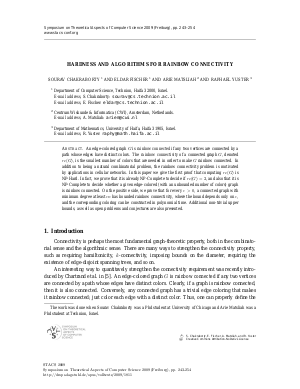Hardness and Algorithms for Rainbow Connectivity
Authors Sourav Chakraborty, Eldar Fischer, Arie Matsliah, Raphael Yuster
-
Part of:
Volume:
26th International Symposium on Theoretical Aspects of Computer Science (STACS 2009)
Part of: Series: Leibniz International Proceedings in Informatics (LIPIcs)
Part of: Conference: Symposium on Theoretical Aspects of Computer Science (STACS) - License:
 Creative Commons Attribution-NoDerivs 3.0 Unported license
Creative Commons Attribution-NoDerivs 3.0 Unported license
- Publication Date: 2009-02-19
File

PDF
LIPIcs.STACS.2009.1811.pdf
- Filesize: 142 kB
- 12 pages
Document Identifiers
Metrics
- Access Statistics
-
Total Accesses (updated on a weekly basis)
0PDF Downloads0Metadata Views
Abstract
An edge-colored graph $G$ is {\em rainbow connected} if any two vertices are connected by a path whose edges have distinct colors. The {\em rainbow connectivity} of a connected graph $G$, denoted $rc(G)$, is the smallest number of colors that are needed in order to make $G$ rainbow connected. In addition to being a natural combinatorial problem, the rainbow connectivity problem is motivated by applications in cellular networks. In this paper we give the first proof that computing $rc(G)$ is NP-Hard. In fact, we prove that it is already NP-Complete to decide if $rc(G)=2$, and also that it is NP-Complete to decide whether a given edge-colored (with an unbounded number of colors) graph is rainbow connected. On the positive side, we prove that for every $\epsilon >0$, a connected graph with minimum degree at least $\epsilon n$ has bounded rainbow connectivity, where the bound depends only on $\epsilon$, and the corresponding coloring can be constructed in polynomial time. Additional non-trivial upper bounds, as well as open problems and conjectures are also presented.
Cite As Get BibTex
Sourav Chakraborty, Eldar Fischer, Arie Matsliah, and Raphael Yuster. Hardness and Algorithms for Rainbow Connectivity. In 26th International Symposium on Theoretical Aspects of Computer Science. Leibniz International Proceedings in Informatics (LIPIcs), Volume 3, pp. 243-254, Schloss Dagstuhl – Leibniz-Zentrum für Informatik (2009)
https://doi.org/10.4230/LIPIcs.STACS.2009.1811
BibTex
@InProceedings{chakraborty_et_al:LIPIcs.STACS.2009.1811,
author = {Chakraborty, Sourav and Fischer, Eldar and Matsliah, Arie and Yuster, Raphael},
title = {{Hardness and Algorithms for Rainbow Connectivity}},
booktitle = {26th International Symposium on Theoretical Aspects of Computer Science},
pages = {243--254},
series = {Leibniz International Proceedings in Informatics (LIPIcs)},
ISBN = {978-3-939897-09-5},
ISSN = {1868-8969},
year = {2009},
volume = {3},
editor = {Albers, Susanne and Marion, Jean-Yves},
publisher = {Schloss Dagstuhl -- Leibniz-Zentrum f{\"u}r Informatik},
address = {Dagstuhl, Germany},
URL = {https://drops.dagstuhl.de/entities/document/10.4230/LIPIcs.STACS.2009.1811},
URN = {urn:nbn:de:0030-drops-18115},
doi = {10.4230/LIPIcs.STACS.2009.1811},
annote = {Keywords: }
}
